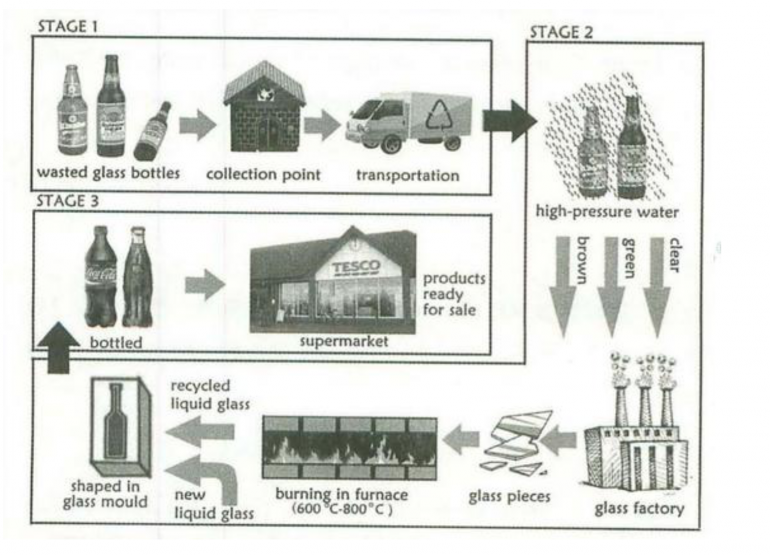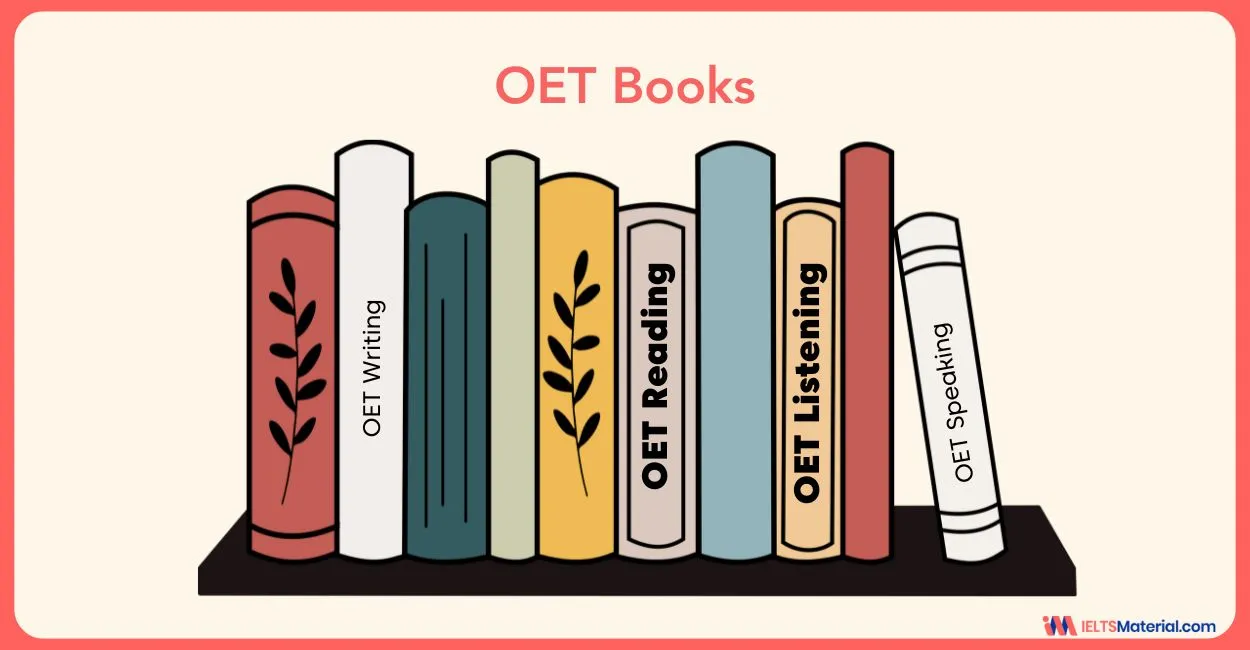Recycling Process of Wasted Glass Bottles - IELTS Writing Task 1
6 min read
Updated On
-
Copy link
Master IELTS Writing Task 1 with three Band 7–9 sample answers for the process diagram question on the Recycling Process of Wasted Glass Bottles. Learn how to effectively describe process diagrams and boost your writing score.
Table of Contents
- Question
- Structural Breakdown
- Recycling Process of Wasted Glass Bottles - Sample Answer 1
- Recycling Process of Wasted Glass Bottles - Sample Answer 2
- Recycling Process of Wasted Glass Bottles - Sample Answer 3
- Things to Keep in Mind While Framing the Answer for Recycling Process of Wasted Glass Bottles Task 1
- Connectors Used in the Sample Answers of ‘Recycling Process of Wasted Glass Bottles’

IELTS Writing Prediction Questions for 2024
In the IELTS Academic Writing Task 1, candidates are often presented with a process diagram, a visual representation of the steps involved in a sequence or cycle. These diagrams typically illustrate how something works or transforms over time, such as the Recycling Process of Wasted Glass Bottles.
To tackle this IELTS process diagram task effectively, it’s essential to understand the structure, use appropriate vocabulary, and clearly describe each stage of the process. Regular practice with IELTS Writing Task 1 practice tests helps you become familiar with common diagram types and boosts your ability to write a coherent, well-organized response.
To support your preparation, this blog includes three IELTS Writing Task 1 sample answers, Band 7, Band 8, and Band 9—for the Recycling Process of Wasted Glass Bottles. These samples will help you understand the difference in performance levels and refine your writing skills accordingly.
To learn more about IELTS Process diagrams like recycling glass bottles, check out the video given below.
Question
- You should spend about 20 minutes on this task.
- The picture below shows the recycling process of wasted glass bottles. Summarise the information by selecting and reporting the main features, and make a comparison where relevant.
- Write at least 150 words.

Structural Breakdown
Introduction
Overview
Body Paragraph 1
Body Paragraph 2
Note: The overview paragraph can be merged with the introduction. However, make sure to use relevant IELTS Writing Task 1 connectors. |
Have questions about IELTS process diagrams? Get answers from our experts, Book a free trial today!
Recycling Process of Wasted Glass Bottles - Sample Answer 1
The diagram illustrates numerous stages in the recycling of waste glass bottles.
There are three key stages shown in the diagram, beginning with the collection of the used glass bottles and ending with the delivery of products in new bottles to retail outlets, such as supermarkets.
In the first stage, waste bottles are deposited at collection points, where they are loaded onto trucks for delivery to a glass recycling facility. The second stage begins with the process of cleaning the bottles with high-pressure water, and they are then separated into a clear, green and brown glass. This is then broken into pieces in the glass factory and passed through a furnace, where they are burned at a temperature of 600 to 800 degrees Celsius. This recycled glass is transformed into liquid form, and it is joined with new liquid glass, ready for moulding into a bottle shape.
In the final stage, the new bottles are used for different products, ready for sale in supermarkets or shops.
Join our free IELTS webinars to explore step by step guides on crafting a Band 8+ answers!
Recycling Process of Wasted Glass Bottles - Sample Answer 2
The diagram illustrates the step-by-step recycling process of glass bottles, beginning with collection and ending with the reuse of the bottles. Overall, the process involves three main stages: preparation, processing, and reproduction.
In the first stage, wasted glass bottles are gathered at collection points and transported to a recycling plant. At the plant, they are washed thoroughly with high-pressure water to remove impurities. Next, the bottles are sorted into three categories based on their colors: brown, green, and clear. In the second stage, the sorted bottles are crushed into small glass pieces and then heated in a furnace at temperatures between 600°C and 800°C. The melted glass is combined with other materials to form new liquid glass.
In the final stage, the liquid glass is shaped into new bottles using molds. These newly formed bottles are then filled with beverages and distributed to supermarkets, ready for sale, completing the recycling loop. This process effectively reduces waste and ensures the sustainable reuse of materials.
Looking for IELTS Preparation Guides? Buy Our IELTS Writing Task 1 Academic Book Now!
Recycling Process of Wasted Glass Bottles - Sample Answer 3
The diagram depicts the recycling process of glass bottles, illustrating how discarded bottles are collected, processed, and transformed into new bottles ready for reuse. On the whole, the entire procedure is divided into three key stages: collection, processing, and reproduction.
Initially, used glass bottles are deposited at designated collection points and transported by specialized vehicles to a recycling plant. Here, the bottles undergo a thorough cleaning process using high-pressure water to eliminate dirt and other contaminants. Following this, they are sorted by color into brown, green, and clear categories.
In the subsequent stage, the sorted bottles are crushed into smaller fragments, which are then melted in a furnace at a temperature range of 600°C to 800°C. The molten glass is blended with raw materials to form new liquid glass.
Finally, the liquid glass is shaped into new bottles using molds. These bottles are then filled with beverages, transported to supermarkets, and made available for sale, completing the cycle.
To conclude, this efficient process highlights the importance of recycling in minimizing waste and conserving resources, while promoting sustainable manufacturing practices.
Want to get your IELTS Writing Task 1 answers evaluated by IELTS experts? Get Evaluated for FREE!
Things to Keep in Mind While Framing the Answer for Recycling Process of Wasted Glass Bottles Task 1
Here are 5 key IELTS Academic Writing Task 1 tips for writing about the ‘Recycling Process of Wasted Glass Bottles’:
- Introduction & Paraphrasing - Briefly introduce the diagram and paraphrase the task statement. Mention the recycling process and key stages.
- Provide an Overview - Summarize the process in 2-3 sentences. Highlight the three main stages: collection, processing, and reproduction.
- Use Sequencing Language - Use words like 'initially', 'next', 'subsequently', and 'finally' to describe each step in a logical flow.
- Focus on Key Details - Describe each stage clearly. Include technical details, such as high-pressure water cleaning, sorting by color, and burning at 600°C to 800°C.
- Use Passive Voice & Formal Vocabulary - Emphasize processes rather than who performs them (e.g., 'bottles are cleaned' rather than 'workers clean the bottles'). Use precise and technical terms, like melted, molded, and reused.
Connectors Used in the Sample Answers of ‘Recycling Process of Wasted Glass Bottles’
Connectors/Linking Words for Writing, also known as connectives or transition words, are words or phrases that link ideas or parts of a sentence or paragraph together. Here are some of the connectors used in the above sample answers on the topic – Recycling Process of Wasted Glass Bottles:
- First/Initially
- Then/After that/Following that
- In the following phase
- All things considered
- That being said
- Overall
- In the initial phases
- Moving on to the final stages
It is important to proofread your IELTS Writing Task 1 answer carefully to check for any grammar, vocabulary, or spelling mistakes. It will help you create well-organized and logical responses for similar IELTS Writing Task 1 Process Diagram, like ‘Recycling Process of Wasted Glass Bottles’.
Also Check:
- The Diagrams below Show the life cycle of the Silkworm and the Stages in the Production of Silk Cloth- IELTS Writing Task 1
- Academic IELTS Writing Task 1 Recycling process of wasted glass bottles Sample Answers
- IELTS Academic Writing Task 1 Process Diagram (Video)
- IELTS Writing Task 1 Process Chart with Sample Answers
- IELTS Academic Writing Task 1: Two different processes for manufacturing black tea – Diagram
- IELTS Academic Writing Task 1 Topic 10: How apple is canned – Diagram
Practice IELTS Writing Task 1 based on report types

Proven tips to score Band 9 in IELTS Writing
Recent Articles

Nehasri Ravishenbagam

Nehasri Ravishenbagam

Kasturika Samanta





Post your Comments
7 Comments